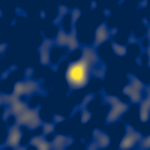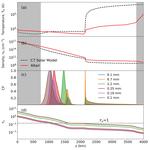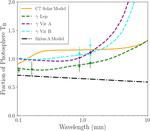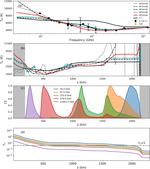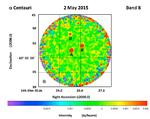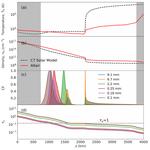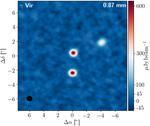Kinich Pakal
 F. Tapia-Vázquez & De la Luz, 2020
F. Tapia-Vázquez & De la Luz, 2020The atmosphere of the Solar-like stars is composed of the photosphere, chromosphere, transition zone, and corona. The chromosphere is the layer where the temperature goes from 4000 K to 8000 K and is studied at ultraviolet, visible, infrared, millimeter and (sub)-millimeter wavelengths (Wedemeyer et al. 2016)1. The first chromospheric models were obtained thanks to the ultraviolet observations (Vernazza et al. 1981; Avrett & Loeser 2008)2 3. However, recent observations made with the Solar Submillimeter Telescope (SST) and the Atacama Large Millimeter / Submillimeter Array (ALMA) have shown that the chromosphere has lower temperatures than expected by ultraviolet models (Linsky 2017). 4
We have developed the KINICH-PAKAL (Tapia-Vázquez, & De la Luz 2020)5 code that use the Levenberg-Marquard algorithm as a nonlinear fit method, PAKAL-MPI as a chromospheric model of the solar atmosphere, and observations at wavelengths ranging from infrared to millimeter to generate a more accurate model of the chromospheres of the solar-type stars. KINICH-PAKAL has allowed us to study in detail how the physical conditions of the atmosphere change as a function of its effective temperature. Developing these models is necessary for debris disk studies (White et al. 2018)6, study the conditions under which flares are formed (MacGregor et al.2018)7 and the possible physical mechanisms of flux variations in the stars (Liseau 2019)8.
References
Wedemeyer, S., Bastian, T., Brajša, R., et al. 2016, SSRv, 200, 1. ↩︎
Vernazza, J. E., Avrett, E. H., & Loeser, R. 1981, ApJS,45, 635. ↩︎
Avrett, E. H., & Loeser, R. 2008, ApJS, 175, 229. ↩︎
Linsky, J. L. 2017, ARA&A, 55, 159. ↩︎
Tapia-Vázquez, F., & De la Luz, V. 2020, ApJS, 246, 5. ↩︎
White, J.A., Aufdenberg, J., Boley, A.C., 2018, ApJ,859(2), p.102. ↩︎
MacGregor, M. A., Weinberger, A. J., Wilner, D. J., Kowalski, A. F., & Cranmer, S. R. 2018, ApJ, 855, L2. ↩︎
Liseau, R. 2019, arXiv:1904.03043. ↩︎
